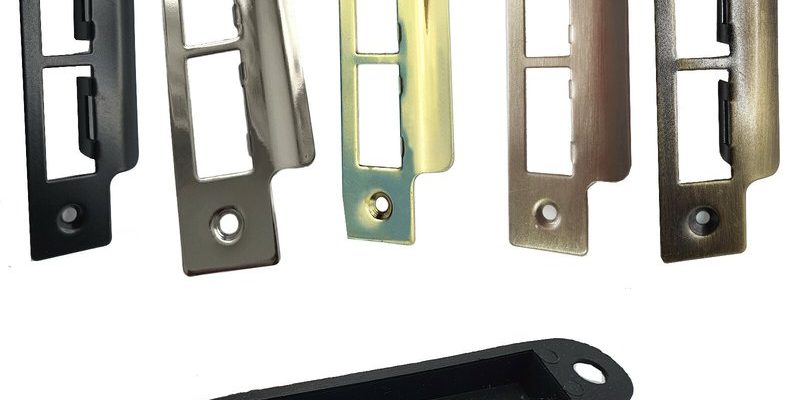
You might be wondering what exactly a door strike plate dust box is. Simply put, it’s a framed enclosure that holds the strike plate in place, protecting it from dust and debris while allowing your door latch to engage properly. In this guide, we’ll explore the best materials for these dust boxes, diving into how they compare and why they matter for your door’s performance. Whether you’re upgrading your doors or just curious, you’re in the right place.
Understanding Door Strike Plate Dust Boxes
To start, let’s break down what a door strike plate and its dust box do. The strike plate is a metal plate secured to the door frame with a hole for the latch to fit into. The dust box, then, is the enclosure that holds this plate, ensuring the latch aligns correctly every time you close the door. Imagine it like a mailbox; without a solid box, the letters (or in this case, the latch) might not stay secure or aligned.
These strike plate dust boxes can be made from various materials, each with its unique strengths and weaknesses. The choice of material affects not just the dust box itself but also the overall security and performance of your door system. So, let’s explore the most popular materials and what they bring to the table.
Steel: The Heavyweight Champion
Steel is often regarded as the best material for door strike plate dust boxes because of its incredible durability and strength. Think of it as the heavyweight champion in the door hardware arena. It can withstand forceful impacts, making it a great option for security doors.
One of the main benefits of steel dust boxes is their resistance to wear and tear. They typically feature corrosion-resistant finishes, so they can handle outdoor elements without rusting. Even in high-traffic areas, a steel dust box remains reliable, maintaining its shape and function over time. However, while they can be a bit pricier upfront, the investment pays off in peace of mind and longevity.
Pros of Steel Dust Boxes
- Incredibly strong and durable
- Resistant to corrosion
- Ideal for security applications
- Can endure high-traffic use
Brass: A Touch of Elegance
If you’re aiming for a classic look, brass dust boxes might be the way to go. Many homeowners love brass not just for its aesthetic appeal but also for its natural properties. It develops a lovely patina over time, adding character to your door hardware.
Brass is less durable than steel, but it still offers decent strength. It’s also resistant to corrosion, which is essential for outdoor applications. However, this material is more prone to scratches and dents, so be cautious in high-traffic settings. If you value beauty alongside functionality, a brass dust box can be a wonderful addition to your door hardware.
Pros of Brass Dust Boxes
- Aesthetic appeal with a classic look
- Develops a unique patina over time
- Resistant to corrosion
- Provides decent strength
Aluminum: Light and Versatile
Next up, we have aluminum. This lightweight material is a good option for those seeking a balance between price and functionality. Aluminum dust boxes are easy to install and work well in various door types.
While aluminum is not as strong as steel, it’s still a reliable choice for many applications. Its inherent resistance to rust makes it suitable for both indoor and outdoor use. Plus, it’s often more affordable than steel or brass. However, if you’re looking for maximum security, aluminum may not provide the same level of protection, particularly in high-impact scenarios.
Pros of Aluminum Dust Boxes
- Lightweight and easy to install
- Corrosion-resistant for outdoor use
- Typically more affordable
- Versatile for various door types
Plastic: The Budget-Friendly Option
When budget constraints come into play, plastic dust boxes can be an appealing option. They’re lightweight and can be found at a lower price point compared to metal options. Plastic dust boxes also resist rust, making them suitable for moist environments.
However, plastic isn’t as strong as metal, so it’s typically best used in low-traffic areas or for interior doors. While they may not offer the same level of security or longevity as metal, they can still provide reliable performance for light use. Keep in mind that the durability might not hold up as well against heavy impacts.
Pros of Plastic Dust Boxes
- Cost-effective and budget-friendly
- Lightweight for easy installation
- Rust-resistant for damp conditions
- Suitable for lower traffic areas
Comparing Materials: Which is Right for You?
Choosing the right material for your door strike plate dust box really depends on your needs. Here are a few factors to consider:
– Security: If you’re after strong security, steel is the best bet. For a more decorative option where security is less of a concern, brass can add flair.
– Budget: Plastic offers the lowest upfront cost, but keep in mind its limitations in strength and longevity. Aluminum is a solid middle ground.
– Usage: For high-traffic doors, go with steel or brass. For interior or low-traffic doors, plastic or aluminum makes sense.
Ultimately, weighing these factors will help you find what suits your situation best.
Deciding on the best material for door strike plate dust boxes isn’t just about picking what looks good. It’s about finding a balance between functionality, aesthetics, and your specific needs. While steel offers unbeatable strength, brass adds a touch of elegance. Aluminum is perfect for versatility, and plastic can fit the budget.
In the end, no matter which material you choose, ensuring that your dust box fits well and is installed correctly is crucial for optimal performance. So take your time, consider your options, and you’ll make a choice that stands the test of time—just like a well-made door deserves!
